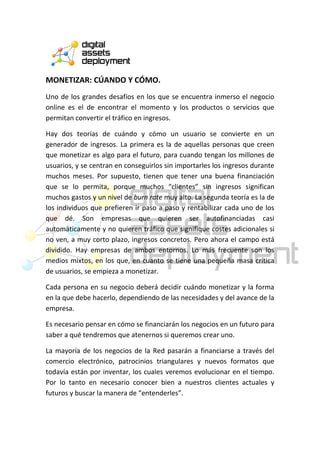
Monetizar: cúando y cómo
- 1. MONETIZAR: CÚANDO Y CÓMO. Uno de los grandes desafíos en los que se encuentra inmerso el negocio online es el de encontrar el momento y los productos o servicios que permitan convertir el tráfico en ingresos. Hay dos teorías de cuándo y cómo un usuario se convierte en un generador de ingresos. La primera es la de aquellas personas que creen que monetizar es algo para el futuro, para cuando tengan los millones de usuarios, y se centran en conseguirlos sin importarles los ingresos durante muchos meses. Por supuesto, tienen que tener una buena financiación que se lo permita, porque muchos “clientes” sin ingresos significan muchos gastos y un nivel de burn rate muy alto. La segunda teoría es la de los individuos que prefieren ir paso a paso y rentabilizar cada uno de los que dé. Son empresas que quieren ser autofinanciadas casi automáticamente y no quieren tráfico que signifique costes adicionales si no ven, a muy corto plazo, ingresos concretos. Pero ahora el campo está dividido. Hay empresas de ambos entornos. Lo más frecuente son los medios mixtos, en los que, en cuanto se tiene una pequeña masa crítica de usuarios, se empieza a monetizar. Cada persona en su negocio deberá decidir cuándo monetizar y la forma en la que debe hacerlo, dependiendo de las necesidades y del avance de la empresa. Es necesario pensar en cómo se financiarán los negocios en un futuro para saber a qué tendremos que atenernos si queremos crear uno. La mayoría de los negocios de la Red pasarán a financiarse a través del comercio electrónico, patrocinios triangulares y nuevos formatos que todavía están por inventar, los cuales veremos evolucionar en el tiempo. Por lo tanto en necesario conocer bien a nuestros clientes actuales y futuros y buscar la manera de “entenderles”.
- 2. Veremos dentro de unos años cómo esta nueva forma de financiación actúa en las empresas. En Internet es necesario “pactar” los precios con los clientes, dar a cada uno el precio que está dispuesto a pagar por las prestaciones que pide. Hay que disponer de sistemas interactivos que nos hagan llegar la voz del usuario, y debemos pactar con ellos el precio de lo que les queremos cobrar, cuándo hacerlo y por qué lo hacemos. Netscape perdió la partida cuando dejó de consultar a sus clientes. Sacó una versión que no había consultado con ellos y que era mucho peor que el Internet Explorer que salió casi al mismo tiempo y que recogía muchas de las pegas que habían manifestado los usuarios. Una de las claves en el negocio es consultar con los clientes los productos que se quieren sacar al mercado, por si no les interesan o no van a tener el éxito que se busca y así inventar otros. Uno de los mayores problemas que nos encontramos en Internet es la tendencia natural que hay a la gratuidad. Muchas de las cosas que hoy pagamos nos las podemos encontrar más tarde en otro sitio gratis, por lo que dejamos de pagar por ellas. Por ello los negocios de la Red son de ciclos cortos, con mucho margen durante muy poco tiempo, y solo las empresas que están innovando constantemente son las que van por delante de esa ola de gratuidad que siempre está a punto de alcanzarnos. Hay que intentar ser innovadores y crear ese tipo de negocios que superan a esa ola de gratuidad.
